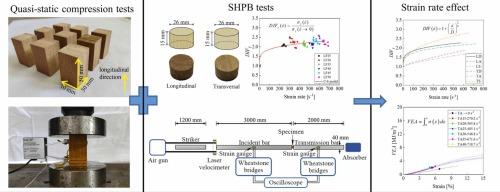Quasi-static and dynamic compressive behavior of bamboo scrimber subjected to air-dried, aged, and saturated treatments
IF 6.2
1区 农林科学
Q1 AGRICULTURAL ENGINEERING
引用次数: 0
Abstract
Bamboo scrimber, as an eco-friendly and sustainable biomass composite material, holds significant potential for structural applications. However, its structural use exposes it to potential dynamic impact loads, hygrothermal conditions, and inevitable aging. A comprehensive understanding of its dynamic compressive behavior is essential for the impact-resistant design of bamboo scrimber structures. In this study, the quasi-static and dynamic compressive mechanical properties of bamboo scrimber are investigated across a range of strain rates, from 6.7 × 10−4 s−1 to around 700 s−1. The influence of two loading directions (longitudinal and transversal) and three specimen conditions (air-dried, aged, saturated conditions) on strain rate effect and energy absorption of bamboo scrimber is evaluated. Test results show that the yield and ultimate compressive strengths of bamboo scrimber increase nonlinearly with strain rate. The Dynamic Increase Factors (DIFs) for these strengths can be effectively described as a function of strain rate using the classical Cowper–Symonds (C-S) model. Under compressive loading, both aged and saturated bamboo scrimber exhibit higher strain rates and more severe damages, but lower mechanical properties and energy absorption than air-dried specimens. Additionally, aging treatment significantly reduces the DIF of the yield and ultimate compressive strength, primarily due to the degradation of inter-fiber bonding behavior in bamboo scrimber. In contrast, saturation treatment enhances the DIF under transversal impact loading while having minimal influence on the DIF under longitudinal impact. Under low-velocity impact, air-dried bamboo scrimber is more susceptible to the micro-inertia effect than to shock wave phenomena, regardless of the impact loading direction.

竹材经受风干、陈化和饱和处理的准静态和动态压缩行为
竹材作为一种生态友好、可持续的生物质复合材料,在结构应用方面具有巨大的潜力。然而,它的结构使用暴露了潜在的动态冲击载荷,湿热条件和不可避免的老化。全面了解竹材结构的动态压缩特性对竹材结构的抗冲击设计至关重要。在本研究中,研究了竹纤维在6.7 × 10−4 s−1到700 s−1的应变速率范围内的准静态和动态压缩力学性能。研究了纵向和横向两种加载方向和风干、老化、饱和三种加载状态对竹材应变率效应和能量吸收的影响。试验结果表明,竹材的屈服强度和极限抗压强度随应变率呈非线性增长。这些强度的动态增加因子(DIFs)可以用经典的coper - symonds (C-S)模型有效地描述为应变速率的函数。在压缩荷载作用下,老化和饱和竹材均表现出更高的应变速率和更严重的损伤,但力学性能和能量吸收量低于风干竹材。此外,时效处理显著降低了竹材屈服强度和极限抗压强度的DIF,这主要是由于竹材纤维间粘合行为的退化。相反,饱和处理提高了横向冲击载荷下的DIF,而对纵向冲击载荷下的DIF影响最小。在低速冲击下,无论冲击载荷方向如何,风干竹材更容易受到微惯性效应而不是冲击波现象的影响。
本文章由计算机程序翻译,如有差异,请以英文原文为准。
求助全文
约1分钟内获得全文
求助全文
来源期刊

Industrial Crops and Products
农林科学-农业工程
CiteScore
9.50
自引率
8.50%
发文量
1518
审稿时长
43 days
期刊介绍:
Industrial Crops and Products is an International Journal publishing academic and industrial research on industrial (defined as non-food/non-feed) crops and products. Papers concern both crop-oriented and bio-based materials from crops-oriented research, and should be of interest to an international audience, hypothesis driven, and where comparisons are made statistics performed.
 求助内容:
求助内容: 应助结果提醒方式:
应助结果提醒方式:


